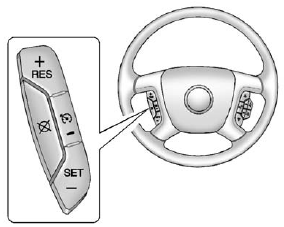Cruise Control
With cruise control, a speed of about 40 km/h (25 mph) or more can be maintained without keeping your foot on the accelerator. Cruise control does not work at speeds below about 40 km/h (25 mph).
When the brakes are applied, the cruise control is disengaged.
WARNING
Cruise control can be dangerous where you cannot drive safely at a steady speed. So, do not use the cruise control on winding roads or in heavy traffic.
Cruise control can be dangerous on slippery roads. On such roads, fast changes in tire traction can cause excessive wheel slip, and you could lose control. Do not use cruise control on slippery roads.

The cruise control buttons are located on left side of the steering wheel.
 (On/Off): Press to turn cruise control on and off. The indicator comes on when cruise control is on.
(On/Off): Press to turn cruise control on and off. The indicator comes on when cruise control is on.
+ RES (Resume/Accelerate):
Press briefly to make the vehicle resume to a previously set speed, or press and hold to accelerate.
SET–: Press to set the speed and activate cruise control or to make the vehicle decelerate.
 (Cancel): Press to disengage cruise control without erasing the set speed from memory.
(Cancel): Press to disengage cruise control without erasing the set speed from memory.
See also:
Head-Up Display (HUD)
WARNING
If the HUD image is too bright or too high in your field of view, it may take you more time to see things you need to see when it is dark outside. Be sure to keep the HUD image dim and placed ...
Additional Maintenance and Care
Your vehicle is an important investment and caring for it properly may help to
avoid future costly repairs. To maintain vehicle performance, additional maintenance
services may be required. It is ...
When It Is Time for New Tires
Factors such as maintenance, temperatures, driving speeds, vehicle loading, and road conditions affect the wear rate of the tires.
Treadwear indicators are one way to tell when it is time for new t ...





